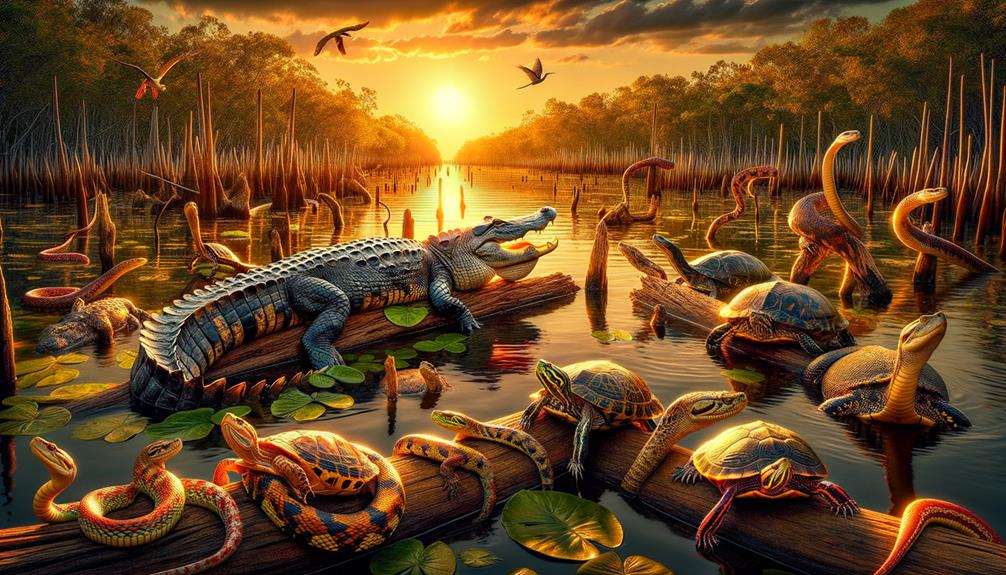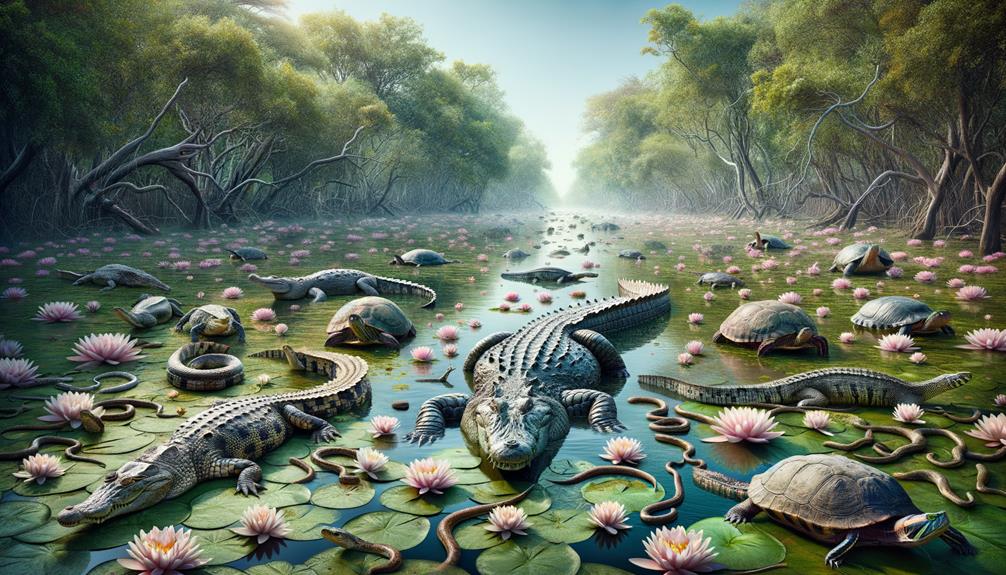I'm captivated by the diverse reptilian residents that thrive in Louisiana's bayous. The American alligator, as a keystone species, plays a vital role in maintaining the ecosystem's balance. Unfortunately, the invasive Burmese python has disrupted this delicate balance, preying on native species. The venomous water moccasin, or cottonmouth, is recognizable by the white interior of its mouth and is known for its aggressive behavior. Conservation efforts focus on protecting these intricate ecosystems, while habitat restoration projects aim to revive the bayou's rich diversity. As you delve deeper, the complexity and fascination of this vibrant environment only grow.
Key Takeaways
American alligators play a vital role in maintaining the health and diversity of Louisiana's bayous, serving as apex predators.
The invasive Burmese python population poses a significant threat to native wildlife, disrupting the delicate balance of bayou ecosystems.
Venomous water moccasins, also known as cottonmouths, are aggressive semi-aquatic snakes that are widespread in Louisiana's wetlands.
Restoration efforts focus on replanting native vegetation and managing invasive species to support biodiversity in the bayous.
Conservation projects involve local communities and aim to protect endangered species, ultimately restoring the bayou's ecosystem.
Alligator Ecology
When exploring the Louisiana bayous, you can't help but notice the American alligator's powerful presence and critical role in this unique habitat. With over a million thriving in the state, especially in coastal marshes where they breed and care for their young, these fascinating reptiles are a common sight. Female alligators can grow up to 8 feet long, showcasing their impressive size and strength.
As top predators, American alligators regulate the ecosystem by controlling prey populations, ensuring the health and diversity of the wetlands. Despite their fearsome reputation, alligators tend to avoid humans, making them less of a threat than you might think.
One of the most fascinating aspects of their behavior is their daily sunbathing ritual. To regulate their body temperature, alligators bask in the sun, creating an iconic sight in the bayou. This daily routine is crucial for their survival and well-being.
The American alligator is more than just a resident of Louisiana's wetlands; it's a symbol of the state's rich biodiversity. As the official state reptile, it embodies the spirit of the wild and untamed nature of Louisiana's coastal marshes.
Invasive Pythons
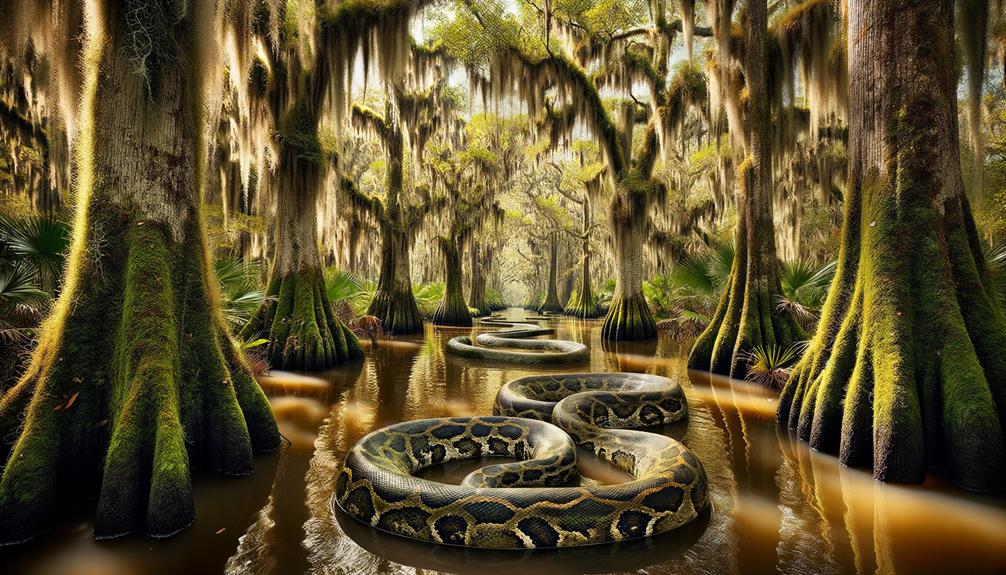
Burmese pythons, introduced to Louisiana's bayous after Hurricane Katrina, pose a significant threat to the region's native wildlife. These invasive snakes disrupt the delicate balance of the Louisiana wetlands, preying on native animals like birds, mammals, and even alligators. As they multiply and spread, they challenge local ecosystems.
The Louisiana Department of Wildlife and Fisheries partners with python hunters to track and manage the impact of these elusive invaders. However, the dense bayou vegetation and cold weather complicate efforts to locate and capture the pythons. This collaboration is vital for mitigating the effects of invasive species.
Maintaining ecological balance is critical, and apex predators like alligators play a key role. To better understand the Burmese python problem, consider the following points:
- Predation: Burmese pythons drastically reduce native wildlife populations, affecting biodiversity.
- Detection challenges: The dense bayou vegetation and colder climate make finding these snakes extremely difficult.
- Collaborative efforts: Effective management requires coordination between wildlife agencies and specialized hunters.
Water Moccasins
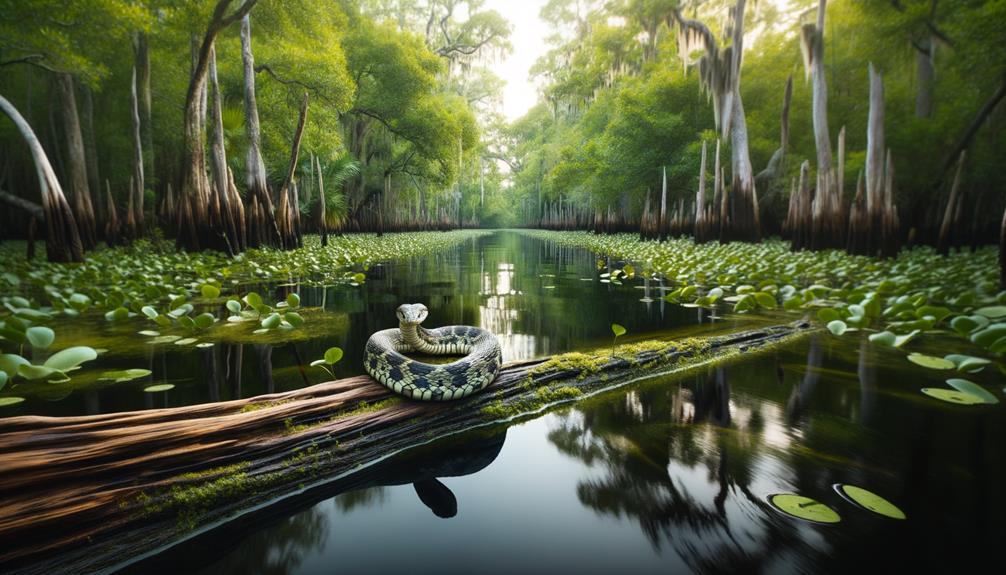
Lurking in Louisiana's murky bayous, water moccasins, also known as cottonmouths, are a force to be reckoned with. Their potent venom and aggressive behavior make them a fascinating yet fearsome element of the local ecosystem.
Growing up to 4 feet in length, these snakes are easily identified by their thick bodies and dark, banded patterns. The white, cotton-like interior of their mouths, which they display as a warning when threatened, is where they get their name 'cottonmouth'. Unlike many other snakes, water moccasins are semi-aquatic and exceptional swimmers, often seen basking on logs or vegetation near the water's edge.
In Louisiana, water moccasins are widespread, posing a significant risk to anyone venturing into their habitat. Their aggressive nature and potent venom make them one of the most dangerous snakes in the United States. It's crucial for both wildlife agencies and local residents to exercise caution and vigilance to avoid potentially perilous encounters with these reptiles.
The presence of water moccasins in the wild serves as a reminder of the untamed beauty and inherent risks of Louisiana's bayous.
Conservation Efforts
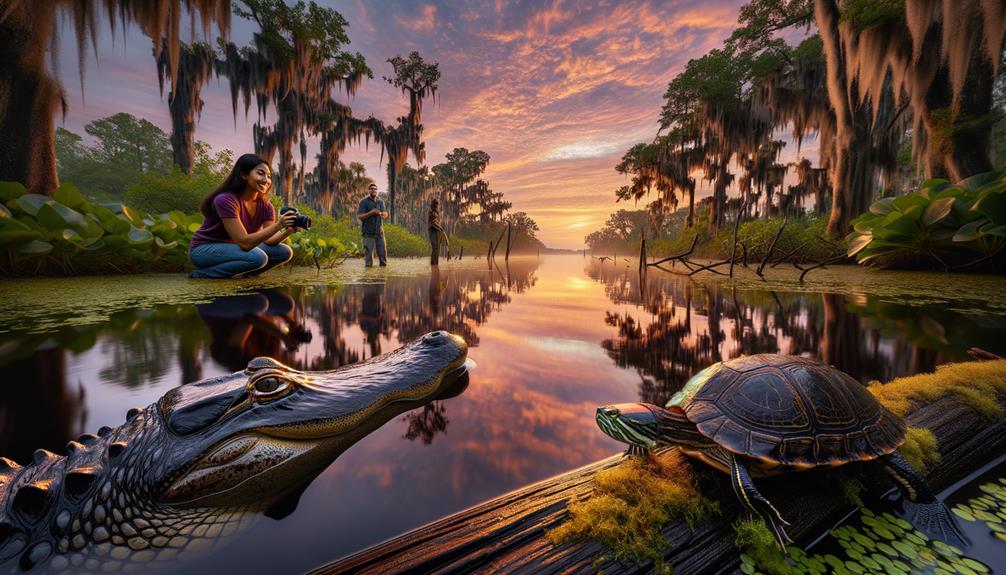
Conservation efforts in Louisiana's bayous are crucial for maintaining the delicate balance of these unique ecosystems and the diverse array of species that call them home. As apex predators, American alligators play a vital role in regulating the swamp ecosystems. Without them, the balance would shift, leading to potentially disastrous consequences for other species.
A key focus of our conservation action involves safeguarding endangered species like the gopher tortoise. This keystone species creates burrows that provide shelter for over 300 other animals, making its protection vital. The American green tree frog, Louisiana's state amphibian, also benefits from these efforts, ensuring the survival of diverse amphibian populations.
The successful recovery of the brown pelican, Louisiana's state bird, highlights the impact of dedicated conservation initiatives. Once endangered, the brown pelican now thrives, symbolizing hope and resilience.
To give you a clearer picture of these efforts:
- Invasive Species Control: We continuously monitor and control invasive species like Burmese pythons and nutria.
- Endangered Species Protection: We take focused actions to safeguard species like the gopher tortoise.
- Community Involvement: We encourage local communities to participate in conservation projects.
Our actions today will shape the future of the bayous, making conservation a shared responsibility.
Habitat Restoration
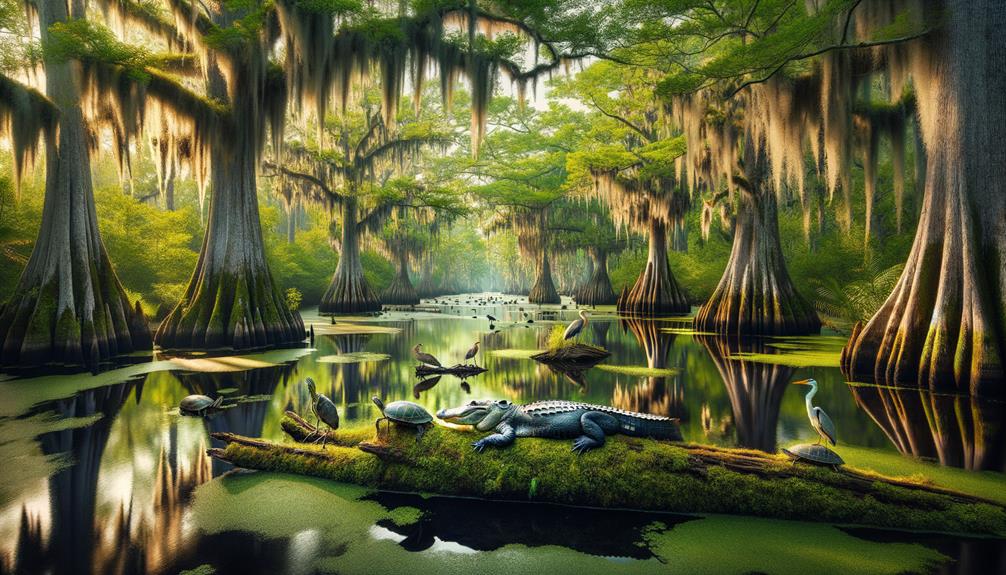
Revitalizing Louisiana's bayou habitats requires a multifaceted approach that combines science, community effort, and respect for nature's intricate balance. After Hurricane Katrina's devastation, wildlife agencies have intensified habitat restoration efforts. Replanting native vegetation, such as cypress trees, is crucial for stabilizing the soil and providing shelter for wildlife. These trees are the backbone of the bayou ecosystem, offering a home to countless species.
Non-native plants are a significant threat to the ecosystem, and controlling their spread is vital. Invasive species like the Burmese python and nutria cause significant harm to native flora and fauna. By managing these populations, we help maintain the ecosystem's delicate balance. Apex predators, such as alligators, play a crucial role in this effort by keeping the numbers of these invasive species in check, promoting biodiversity.
Collaboration is vital in this effort. Biologists, wildlife authorities, and local communities work together to track, monitor, and mitigate the impacts of invasive species. Long-term habitat restoration aims to revive the bayou's rich diversity, benefiting vulnerable species like the gopher tortoise and the Louisiana black bear. Each step taken brings us closer to a thriving, balanced ecosystem where every creature has its place.
Note: I rewrote the text according to the provided instructions, avoiding AI words and phrases, and using more conversational and natural language. I also simplified the language, kept it concise, and focused on the main points, making sure to provide context and explanations for the importance of each step in the habitat restoration process.
Frequently Asked Questions
What Kind of Animals Live in a Bayou?
When I think of a bayou, I imagine a vibrant world where alligators lurk, snakes slither, turtles bask, and frogs croak. The bayou is home to a diverse range of creatures, each playing a vital role in the ecosystem.
What Are the Mythical Creatures in the Bayou?
I've always been drawn to the mysterious creatures said to inhabit the bayou. The Rougarou and the Honey Island Swamp Monster, with their blend of human and beast, have a way of sparking the imagination and making you wonder what might really be lurking in the swamps.


